Is your kombucha not as fizzy as you would like? We’re walking through all the reasons your kombucha isn’t carbonated (and how to fix it)!
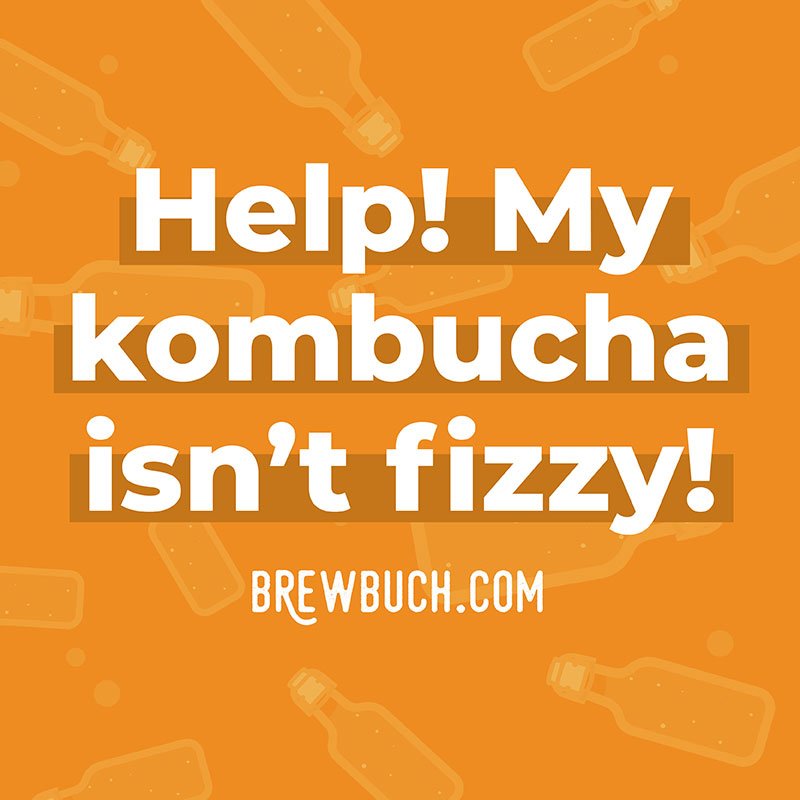
There’s nothing quite like the proud feeling of achievement when you crack open a bottle of fizzy homemade kombucha, all carbonated and bubbly and delicious. The flip side, of course, is when your kombucha isn’t fizzy and you start to wonder where you went wrong (in kombucha? in life?).
So for all the folks with a sad bottle of flat kombucha on your hands (we’ve all been there), this is your troubleshooting guide to help you achieve carbonated kombucha success!
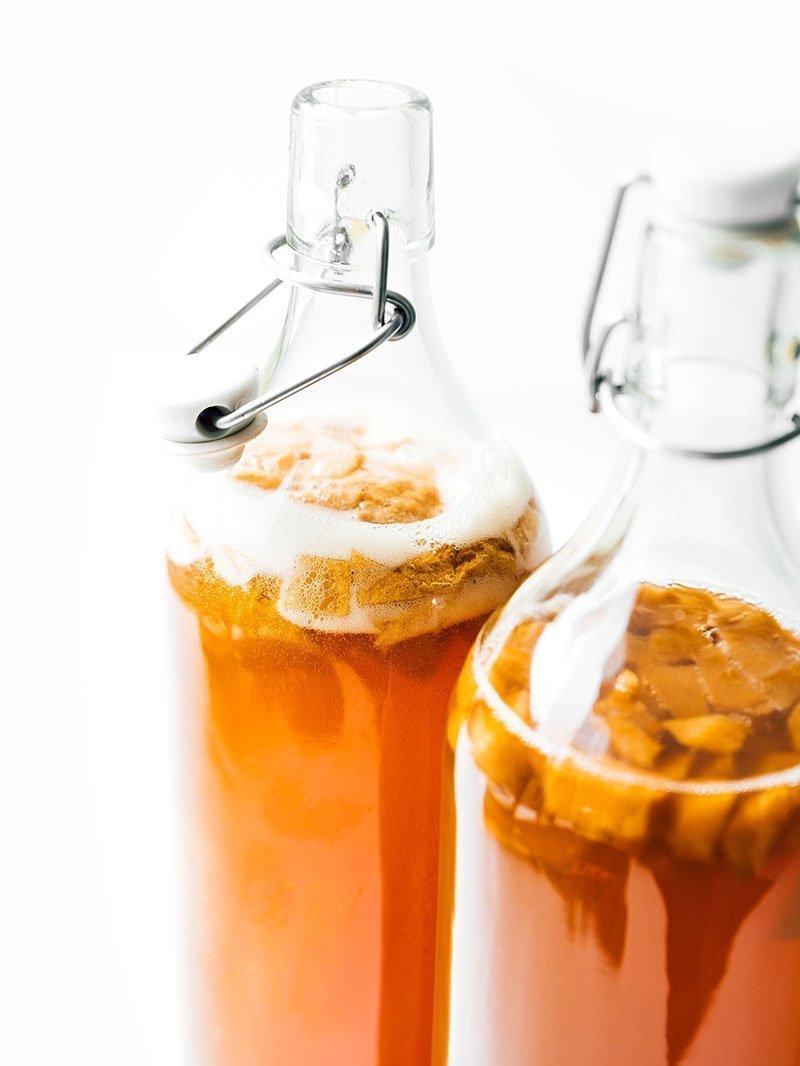
What is carbonation?
Carbonation, put simply, is carbon dioxide (CO2) dissolved in a liquid. In kombucha, the yeasts in your brew eat the sugar and use it to produce alcohol and CO2.
In the first fermentation, the kombucha is covered only with a cloth, meaning the CO2 can escape and doesn’t stay in the liquid. That’s why we do a second fermentation, sealing the kombucha in airtight bottles and trapping the CO2 in the kombucha.
This method of carbonation is called natural carbonation. Another method is called forced carbonation, and this is when machines are used to artificially add carbonation to a drink. Drinks with forced carbonation include carbonated water, soda, and even most store bought kombucha.
While natural carbonation produces a soft feeling, with smaller bubbles and less tingle, forced carbonation is just the opposite. Forced carbonated drinks are usually sharp feeling, with large, uniform bubbles. This is an important distinction, in that you should not expect your home brewed kombucha to have the carbonated feeling of a soft drink.
With that said, you can make some seriously carbonated and fizzy kombucha. Here’s how!
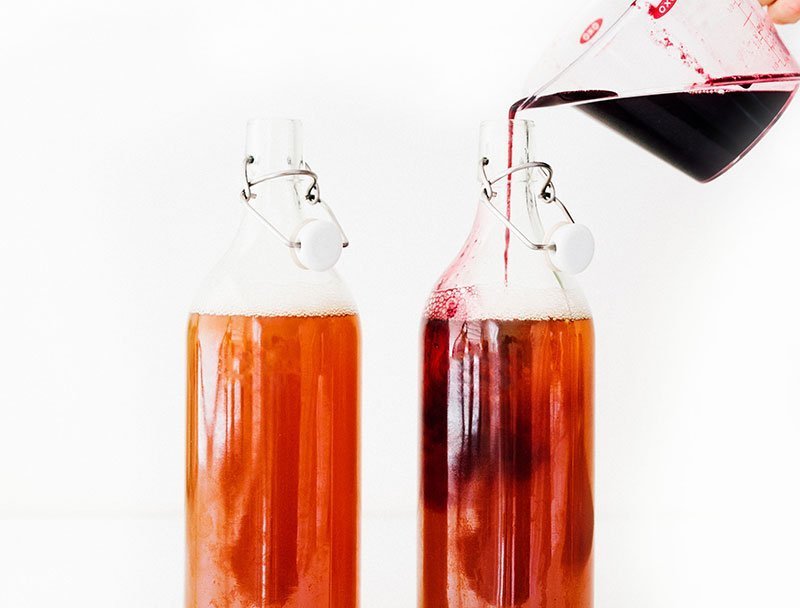
How to carbonate kombucha
To carbonate kombucha, you’ll essentially just transfer your uncarbonated kombucha into airtight bottles, add something sweet as “food”, seal shut, then wait for the bacteria and yeasts to work their magic!
While some carbonation does occur in the first fermentation (the SCOBY can create a light seal, trapping a little fizz in the brew), most of it occurs in the second fermentation Read more about how to brew kombucha here.
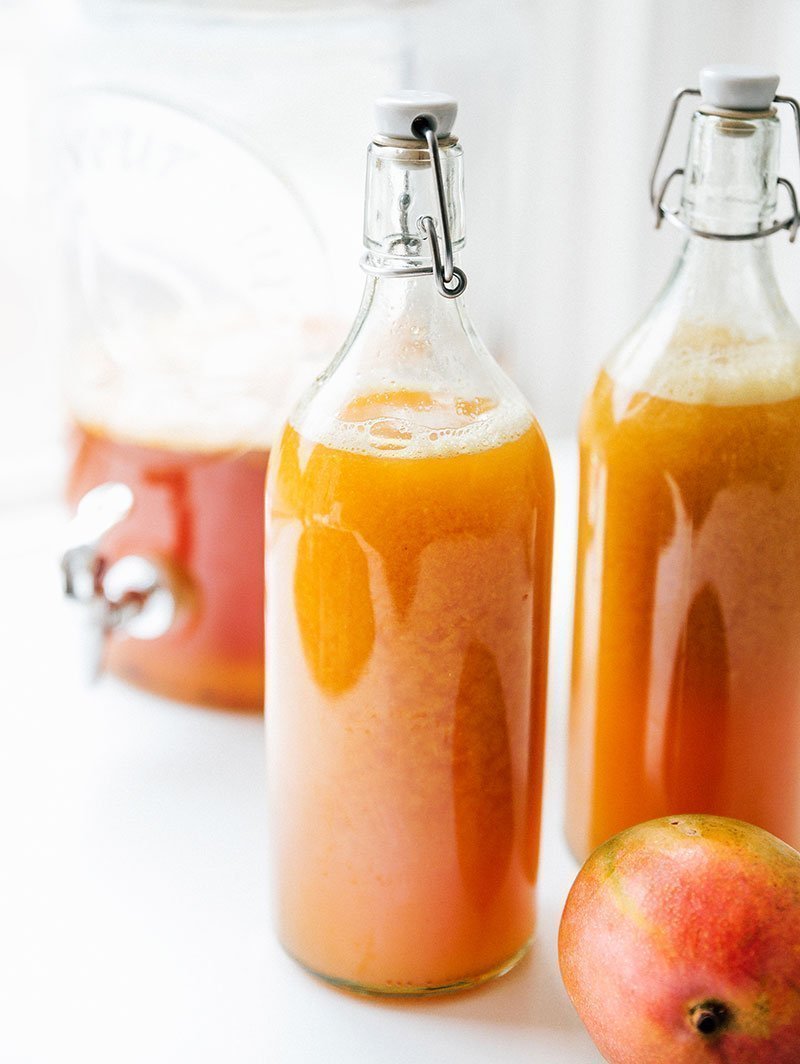
So why isn’t my kombucha fizzy?
This brings us to our question of the hour – why isn’t your kombucha fizzy? This is one of the most common questions we get in our kombucha Facebook group. There are numerous reasons why your kombucha might not have carbonation:
1. You’re not using the right bottles.
You need to use fermentation grade bottles to brew kombucha, as these are specifically designed to not only trap air in, but withstand the pressure build up without exploding or leaking. These flip top bottles and these bottles are both great. For the best buch, avoid decorative bottles and mason jars.
2. You need to adjust your first fermentation time.
Your first fermentation needs to run long enough that there are plenty of bacteria and yeasts built up in the kombucha – these power the carbonation reaction. On the other hand, you should ensure your first fermentation isn’t going so long that your kombucha tastes sour/vinegary – there needs to be some sugar left for the yeast to feed on to help power the carbonation.
3. You’re not letting the second fermentation go long enough.
This one is simple; you may just need to let it (second) ferment longer! A typical second fermentation takes 3 to 10 days, but this could take more time depending on the sugar content and temperature of your house.
4. Your fermentation station is too cold.
Fermentation slows down dramatically when the environment is cold. Ensure your kombucha bottles are somewhere relatively warm (68-78°F). For the winter months, this might mean investing in kombucha heating pads, or finding a warm area in your house (e.g. above the fridge, by a heater, or in the laundry room). Read more on ideal kombucha temperatures here.
5. You’re leaving too much air in the bottles.
It’s important to leave some head space (empty space) at the top of the bottles before sealing, which will act as a buffer for the pressure (and in turn prevent explosions). With that said, if you leave too much head space, the CO2 simply stays in the air inside the bottle rather than going into the kombucha, resulting in less fizz. Aim for about 1 to 2 inches of head space (this entirely depends on the bottle shape and size, so you may need to adjust as you settle into a fermentation routine).
6. You’re not stirring the kombucha before bottling.
If you’re pouring the kombucha straight from the fermentation jug into the bottles (and especially if you’re using a spigot, like in continuous brewing), then the bacteria and yeast are not being evenly distributed into the bottles. Be sure to give your kombucha a stir before bottling so that every jar can be equally full of that live yeast and bacteria power! This also mixes oxygen into the kombucha, which helps to stimulate the process of carbonation.
7. You’re filtering the kombucha before bottling.
By all means, filter the gunk out of the kombucha after the second fermentation, but not before! You want to get all those brown stringy bits (the yeast!) into your second fermentation bottles as well. These will do wonders for the carbonation and fizz.
8. Your tea isn’t strong enough.
It could be that your first fermentation brew just isn’t strong enough. Either add a few more bags of tea, or let the tea steep for longer to infuse your brew with more “food” for the bacteria and yeast.
9. You’re not adding fruit or sugar.
Adding mashed fruits, juices, sugar, or honey not only add flavor, but they are instrumental in carbonating your kombucha. They act as “food” sparking the reaction that creates carbonation. (Pro tip: for maximum fizz, add ginger!) See our favorite kombucha flavors here!
10. You’re burping the bottles too much.
I get it, the idea of a bottle exploding is a little scary (and cleaning up the mess that results? even more so). But if you’re burping your bottles daily to avoid potential catastrophe, you may be doing a disservice to your carbonation. Try holding off on burping your second fermentation bottles for 2 or 3 days if you’re having issues with kombucha not carbonating. (Worried about explosions? Grab a few of these carbonation caps to allow out excess pressure!)
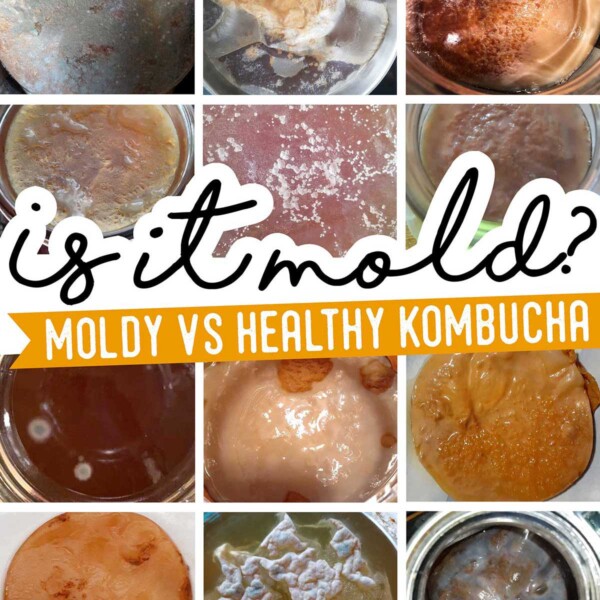
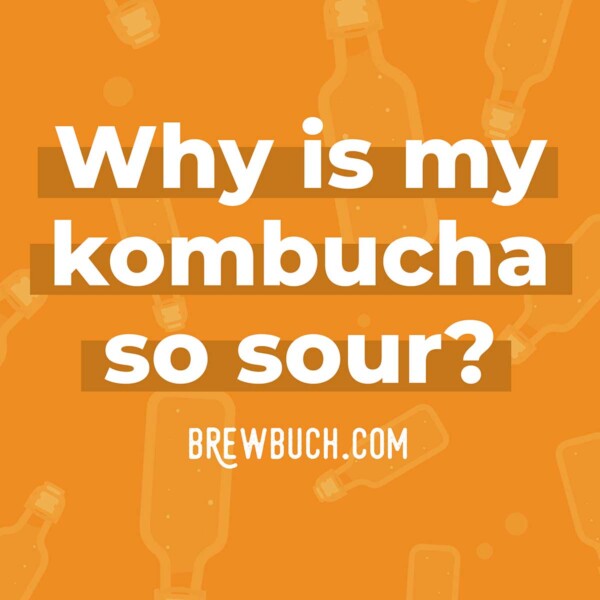
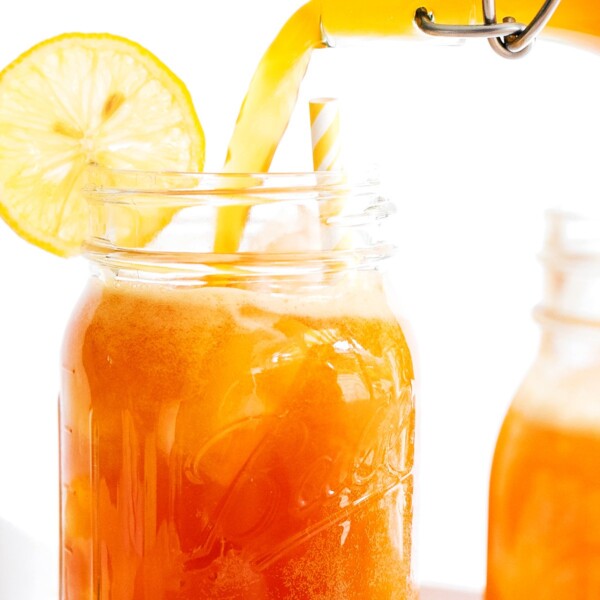
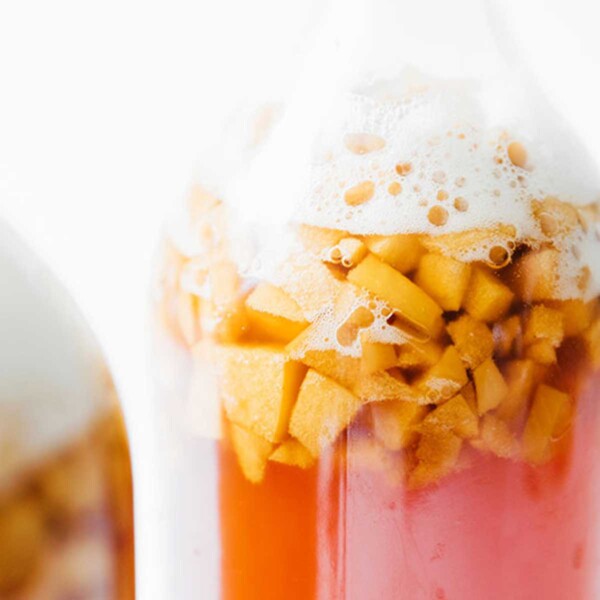
I may be confused. For F2, I thought I was supposed to pour kombucha into my 16oz bottles leaving room to add fruits/sugar each then put the lid on and ferment for a few days. Your instructions about filtering after F2 lead me to believe that I’m not supposed to bottle until AFTER F2. So do I add fruit and sugar to my gallon jar of kombucha for F2 then filter/divide into 16oz bottles? If that’s the case, how do you maintain carbonation if you’re pouring it up after it’s been carbonated in F2. Lots of questions, I know, lol!
TIA
How you states first is correct. F2 is pouring kombucha into bottles, adding sugar/fruit, then putting a lid on it. If you want to filter out the fruit and gunk, you can strain the kombucha right before serving. This will remove a little carbonation, but not all of it.
This is my confusion, too! I do F1 is large wide mouth jar. Then, F2 is where I don’t quite understand. I’ve been putting mine in 1/2 gallon igloo coolers with fruit for F2 then straining into individual glass jars. Not sure what to do.
Hi Sarah!
Your guidance has been very helpful in getting me started making my own kombucha. Mine is so much better than (expensive) store-bought kombucha.
Regarding F2 carbonation, the “fizz”, I have a couple of questions:
1. What is the right amount of which fruit to get good fiz during F2 in 16 oz fermentation bottles?
2. I am using “raw sugar” in my kombuch. Have you found any alternatives for someone who wants good “fizz” and has to watch their sugar intake due to diabetes?
3. Have you found a particular type of tea, tea blends, or brands that are better for good F2 carbonation?
I have a pretty good handle on the taste/time, temperature/pressure, and the biology/chemesty aspects of fermentation (I made my first still in 1981…..shh…). I realy enjoy your suggestions. They help me tweak my brews.
Thanks.
Jim S.
Hi Jim! So happy to hear this info has been helpful for you.
1. Check out our kombucha flavors for specific recipes. I typically flavor by the 1/2 gallon, so it will make 4 16-oz bottles.
2. While you should be using sugar to brew, you can push down the finished sugar content to make it more diabetic friendly. Here’s how!
3. All tea I’ve tried has generally worked pretty well! Here are the best teas to use.
Happy brewing!
I think my problem is too much headspace, but I don’t have anymore first fermentation brew to add to the bottle! What do I do?
You can stick it in the fridge until you have more F1 kombucha to add, then pull it out and let F2 run once the bottle is fuller 😀
Hi,
I wonder if you could help: for a standard 500ml swing top bottle, how much sugar/honey would you add for the second fermentation?
Cheers
Grant
I would add about 1 teaspoon! 😀
Cheers Sarah ????
OK my 2nd fermentation is flat (thinking I let the 1st fermentation go too long & maybe my 2nd too) as it is more vinegary tasting. I normally do NOT add fruit or juice to my 2nd ferment as I like the taste of the fizzy tea.
Question – can I empty the bottles from 2nd flat ferment back into pail & add fruit juice to try to get the sugar from the juice to feed/create fizz and bottle again and try a 3rd ferment? Does this make sense?
Yep you can definitely do that! Sounds like it just ran out of sugar so it didn’t have anything to power the carbonation 😀
These recommendations are great and I have just started a brand new batch of buch, however I have 2 half gallons from my last batch that I had to put into the fridge because I was going to be gone for 2 weeks. I have done second fermentation in the fridge before with no problems but this time there is no fizz. Can I try adding some sugar to them and see if that works or should I just toss them out?
Just pull them out of the fridge so the yeast can become active again. That should do it! 😀
I’ve made several batches of kombucha, and continue to struggle with citrus flavoring in 2nd ferment. Most of my flavorings have nice (or too much) carbonation, but I can’t get any carbonation in my orange vanilla (squeeze orange juice and add vanilla extract) or my lemon lime (squeeze lemon and lime juice and add some zest).
To add, the same batch of kombucha carbonates well with other fruit flavors.
Any thoughts on this? Is it just that there isn’t as much sugar for the yeast to eat in citrus?
You may just need to add a little extra sugar to help power the carbonation in those batches! Lemon and lime especially don’t have much sugar, so if your kombucha is already low on sugar (like if you fermented it for longer in F1), then it’ll need a little bit to carbonate.
Need help! I’ve brewed a number of successful, carbonated batches, but now I’m stumped. Made a delicious orange vanilla simple syrup and I’ve got ZERO carbonation in the bottles after 14 days. Everyone talks about bottle bombs from too much sugar, but I suspect the opposite: the yeast are overwhelmed and won’t consume the massive sugar quantities. I used 1c sugar to 1c water, and used the majority of the syrup over 8 or so pints. This seems like as much as an ounce of sugar per bottle? This doesn’t seem entirely unreasonable to me, but the bottles were sickeningly sweet… I read somewhere about yeast going dormant from too much sugar but can’t find it now. Is that the case? Can too much sugar stunt yeast activity? TIA
Hi Benjamin! I haven’t heard of this before but I suppose that it could be possible! Perhaps even out the sugar ratio by adding more unflavored kombucha, which should get things kickstarted again!
I brewed my first batch of Buch during June and really could have used this article a few weeks ago! I resolved it to a certain degree, but there are a few more tips here I may use for my second batch!
So happy to hear it, Robin! Happy brewing! 😀
This has been a fun adventure as I too had a bottle blow all over me,(my 1st one) kitchen, window, floor, even the dog had chunks of strawberries in his hair, the ounce of beautiful fizzy buch that was left was delish so the idea of opening it in a bowl/baggie will allow me to enjoy this lovely drink, thank you for all the tips and info